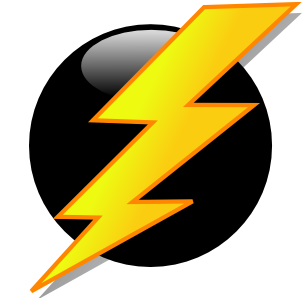The risk is real. One safety switch may not be enough. The Queensland Government is encouraging homeowners and landlords to have electrical safety switches installed on all household circuits. The Risk is real – one safety switch may not be enough advertising campaign raises community awareness of how safety switches reduce the risk of electric shock. Safety switches help protect your family …
What To Do In A Blackout
 What to do first.
What to do first.
Is there lightning close to your premises? If there is lightning striking close to you then it’s a good idea to take some precautionary measures.
First you need to physically unplug all devices and appliances from the socket.
Once this is done it’s time to put your feet up, literally. If your house is struck by lightning you can protect yourself from ground dispersing current spike by adding extra insulation between you and the floor, one thing you can do is sit down on your sofa couch or lounge and put your feet up on it. This way any potential difference between your feet has been eliminated. If your house is higher elevation or is built on such as ground with rich iron in the soil you may receive more lightning strikes than is otherwise probable. In order to protect your house in this case read the following article dealing with lightning protection.
Check out our new graphics
 24HEESC BLOG – New Digs
24HEESC BLOG – New Digs
Mar21 2017
Check out our new graphics. Here at 24 Hour Emergency Electrician Sunshine Coast we are committed to continuous improvement and defining the world class standard in quality service. Along with our customer service, technical knowledge, experience and latest technology we also like to keep abreast of latest in the digital world including web, apps, social media and graphic design. So check out our latest graphics and let us know what you think. Share or like us on your social media of choice, or recommend us to a friend.
Moving A Power Point
24HEESC BLOG – Moving A Power Point
Sep 2016

**WARNING**
ONLY A LICENSED QUALIFIED ELECTRICIAN MAY MOVE A POWER POINT IN AUSTRALIA. IT IS ILLEGAL TO TRY AND MOVE A POWER POINT YOURSELF. THIS ARTICLE IS FOR INFORMATION & INTEREST ONLY AND IS IN NO WAY INTENDED TO INSTRUCT OR GUIDE THE READER TO PERFORM THIS THEMSELVES. AN ALTERED POWER POINT THAT HARMS A PERSON OR RESULTS IN DAMAGE TO A PROPERTY MAY RESULT IN CRIMINAL NEGLIGENCE. IT WILL VOID HOME AND CONTENTS INSURANCE CONTRACT.
So we perform this quite a bit and its interesting to see how its done, but we must stress that you must not try this yourself, it is extremely dangerous, only a licensed electrician can do this. Ok, so lets have a look at how they do it.
Step 0: Proper attire
An electrician will wear thick rubber boots and insulated gloves whilst performing any work in order to reduce the risk of electrocution by adding extra impedance protection in the case of error or failure.
Step 1: Disconnect the power at the mains fusebox / switchboard
This is obviously the most important step. Before working with wires, the electrician must ensure that the wire is cut off from the supply and therefore not ‘live’. To do this the electrician identifies which section of the circuit the power point sits in, and then turns this section of the circuit off at the mains fusebox or switchboard. If unsure the master switch can be disabled so that all power is disconnected to all parts of the circuit.
[…]
Basic Wire Joining
24HEESC BLOG – Basic Wire Joining
Aug 2016

In this post we will show you how to join and extend wires, we will be using a low power application for our example such as a telephone line (5V DC) or audio speaker cabling.
What diameter of wire (likely copper) is appropriate for your purpose? Well it depends entirely on the maximum current the wire is designed to transmit. Generally speaking low current applications use a narrow wire, whereas high current applications require a large diameter wire. See this guide for more info.
You will need:
Wire
Wire strippers and cutters
Solder
A soldering iron
Heat shrink or electrical tape
Heat gun (or the soldering iron will also suffice)
Step 1: Prep your workspace
You want to set up on a flat non conductive surface, a wooden desk bench or table is suitable. Cover the surface with something to protect it from excess flux and solder. A few layers of newspaper usually suffices. Turn on your soldering iron and allow a few minutes for it to heat up to its operating temperature. Make sure the tip of the soldering iron is safely housed in the stand so that it doesn’t burn anything.
RCD Installation
24HEESC BLOG – RCD Installation
Feb 2016

Welcome to our first instalment of our blog on Emergency Electrical job’s in Sunshine Coast.
We begin on a late night job we attended in Stafford, North Sunshine Coast. A lady called us to come out quickly to help get power back on to the entire house. We quickly arrived on-site and went into complete fault find mode. We started by testing the main switchboard and with this testing you have a series of small but crucial methods we use as electricians to get a good understanding of what’s going on with the basic structure of the wiring in the board and in the house.
We continued a visual inspection upstairs in the house and found everything to be ok.
We than started another check and tested the RCD’s or ‘safety switch’ and after that procedure the safety switch protecting the light circuit was failing the test.
The wiring in the bottom of the RCD was installed incorrectly and in turn had burnt out the terminal.
